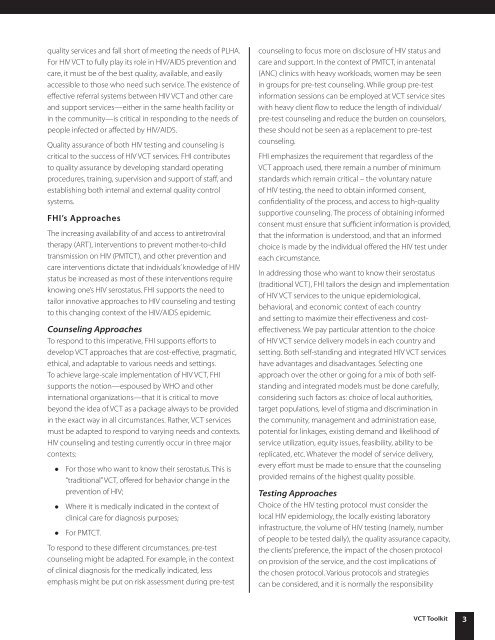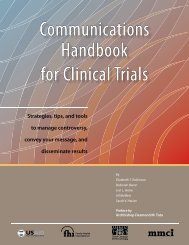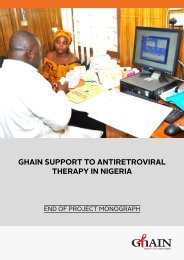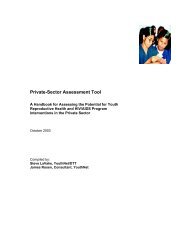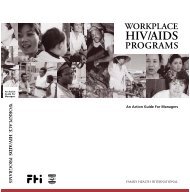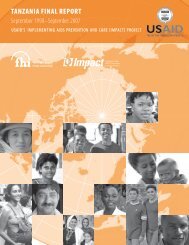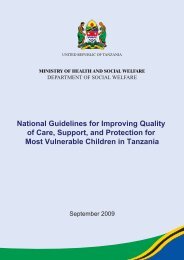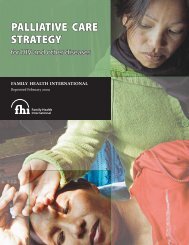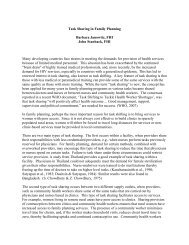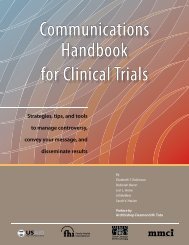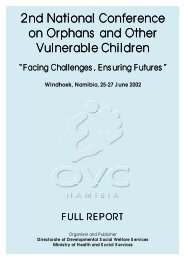Voluntary Counseling and Testing for HIV: A Strategic ... - FHI 360
Voluntary Counseling and Testing for HIV: A Strategic ... - FHI 360
Voluntary Counseling and Testing for HIV: A Strategic ... - FHI 360
You also want an ePaper? Increase the reach of your titles
YUMPU automatically turns print PDFs into web optimized ePapers that Google loves.
quality services <strong>and</strong> fall short of meeting the needs of PLHA.<br />
For <strong>HIV</strong> VCT to fully play its role in <strong>HIV</strong>/AIDS prevention <strong>and</strong><br />
care, it must be of the best quality, available, <strong>and</strong> easily<br />
accessible to those who need such service. The existence of<br />
effective referral systems between <strong>HIV</strong> VCT <strong>and</strong> other care<br />
<strong>and</strong> support services—either in the same health facility or<br />
in the community—is critical in responding to the needs of<br />
people infected or affected by <strong>HIV</strong>/AIDS.<br />
Quality assurance of both <strong>HIV</strong> testing <strong>and</strong> counseling is<br />
critical to the success of <strong>HIV</strong> VCT services. <strong>FHI</strong> contributes<br />
to quality assurance by developing st<strong>and</strong>ard operating<br />
procedures, training, supervision <strong>and</strong> support of staff, <strong>and</strong><br />
establishing both internal <strong>and</strong> external quality control<br />
systems.<br />
<strong>FHI</strong>’s Approaches<br />
The increasing availability of <strong>and</strong> access to antiretroviral<br />
therapy (ART), interventions to prevent mother-to-child<br />
transmission on <strong>HIV</strong> (PMTCT), <strong>and</strong> other prevention <strong>and</strong><br />
care interventions dictate that individuals’ knowledge of <strong>HIV</strong><br />
status be increased as most of these interventions require<br />
knowing one’s <strong>HIV</strong> serostatus. <strong>FHI</strong> supports the need to<br />
tailor innovative approaches to <strong>HIV</strong> counseling <strong>and</strong> testing<br />
to this changing context of the <strong>HIV</strong>/AIDS epidemic.<br />
<strong>Counseling</strong> Approaches<br />
To respond to this imperative, <strong>FHI</strong> supports ef<strong>for</strong>ts to<br />
develop VCT approaches that are cost-effective, pragmatic,<br />
ethical, <strong>and</strong> adaptable to various needs <strong>and</strong> settings.<br />
To achieve large-scale implementation of <strong>HIV</strong> VCT, <strong>FHI</strong><br />
supports the notion—espoused by WHO <strong>and</strong> other<br />
international organizations—that it is critical to move<br />
beyond the idea of VCT as a package always to be provided<br />
in the exact way in all circumstances. Rather, VCT services<br />
must be adapted to respond to varying needs <strong>and</strong> contexts.<br />
<strong>HIV</strong> counseling <strong>and</strong> testing currently occur in three major<br />
contexts:<br />
• For those who want to know their serostatus. This is<br />
“traditional” VCT, offered <strong>for</strong> behavior change in the<br />
prevention of <strong>HIV</strong>;<br />
• Where it is medically indicated in the context of<br />
clinical care <strong>for</strong> diagnosis purposes;<br />
• For PMTCT.<br />
To respond to these different circumstances, pre-test<br />
counseling might be adapted. For example, in the context<br />
of clinical diagnosis <strong>for</strong> the medically indicated, less<br />
emphasis might be put on risk assessment during pre-test<br />
counseling to focus more on disclosure of <strong>HIV</strong> status <strong>and</strong><br />
care <strong>and</strong> support. In the context of PMTCT, in antenatal<br />
(ANC) clinics with heavy workloads, women may be seen<br />
in groups <strong>for</strong> pre-test counseling. While group pre-test<br />
in<strong>for</strong>mation sessions can be employed at VCT service sites<br />
with heavy client flow to reduce the length of individual/<br />
pre-test counseling <strong>and</strong> reduce the burden on counselors,<br />
these should not be seen as a replacement to pre-test<br />
counseling.<br />
<strong>FHI</strong> emphasizes the requirement that regardless of the<br />
VCT approach used, there remain a number of minimum<br />
st<strong>and</strong>ards which remain critical – the voluntary nature<br />
of <strong>HIV</strong> testing, the need to obtain in<strong>for</strong>med consent,<br />
confidentiality of the process, <strong>and</strong> access to high-quality<br />
supportive counseling. The process of obtaining in<strong>for</strong>med<br />
consent must ensure that sufficient in<strong>for</strong>mation is provided,<br />
that the in<strong>for</strong>mation is understood, <strong>and</strong> that an in<strong>for</strong>med<br />
choice is made by the individual offered the <strong>HIV</strong> test under<br />
each circumstance.<br />
In addressing those who want to know their serostatus<br />
(traditional VCT), <strong>FHI</strong> tailors the design <strong>and</strong> implementation<br />
of <strong>HIV</strong> VCT services to the unique epidemiological,<br />
behavioral, <strong>and</strong> economic context of each country<br />
<strong>and</strong> setting to maximize their effectiveness <strong>and</strong> costeffectiveness.<br />
We pay particular attention to the choice<br />
of <strong>HIV</strong> VCT service delivery models in each country <strong>and</strong><br />
setting. Both self-st<strong>and</strong>ing <strong>and</strong> integrated <strong>HIV</strong> VCT services<br />
have advantages <strong>and</strong> disadvantages. Selecting one<br />
approach over the other or going <strong>for</strong> a mix of both selfst<strong>and</strong>ing<br />
<strong>and</strong> integrated models must be done carefully,<br />
considering such factors as: choice of local authorities,<br />
target populations, level of stigma <strong>and</strong> discrimination in<br />
the community, management <strong>and</strong> administration ease,<br />
potential <strong>for</strong> linkages, existing dem<strong>and</strong> <strong>and</strong> likelihood of<br />
service utilization, equity issues, feasibility, ability to be<br />
replicated, etc. Whatever the model of service delivery,<br />
every ef<strong>for</strong>t must be made to ensure that the counseling<br />
provided remains of the highest quality possible.<br />
<strong>Testing</strong> Approaches<br />
Choice of the <strong>HIV</strong> testing protocol must consider the<br />
local <strong>HIV</strong> epidemiology, the locally existing laboratory<br />
infrastructure, the volume of <strong>HIV</strong> testing (namely, number<br />
of people to be tested daily), the quality assurance capacity,<br />
the clients’ preference, the impact of the chosen protocol<br />
on provision of the service, <strong>and</strong> the cost implications of<br />
the chosen protocol. Various protocols <strong>and</strong> strategies<br />
can be considered, <strong>and</strong> it is normally the responsibility<br />
VCT Toolkit 3


